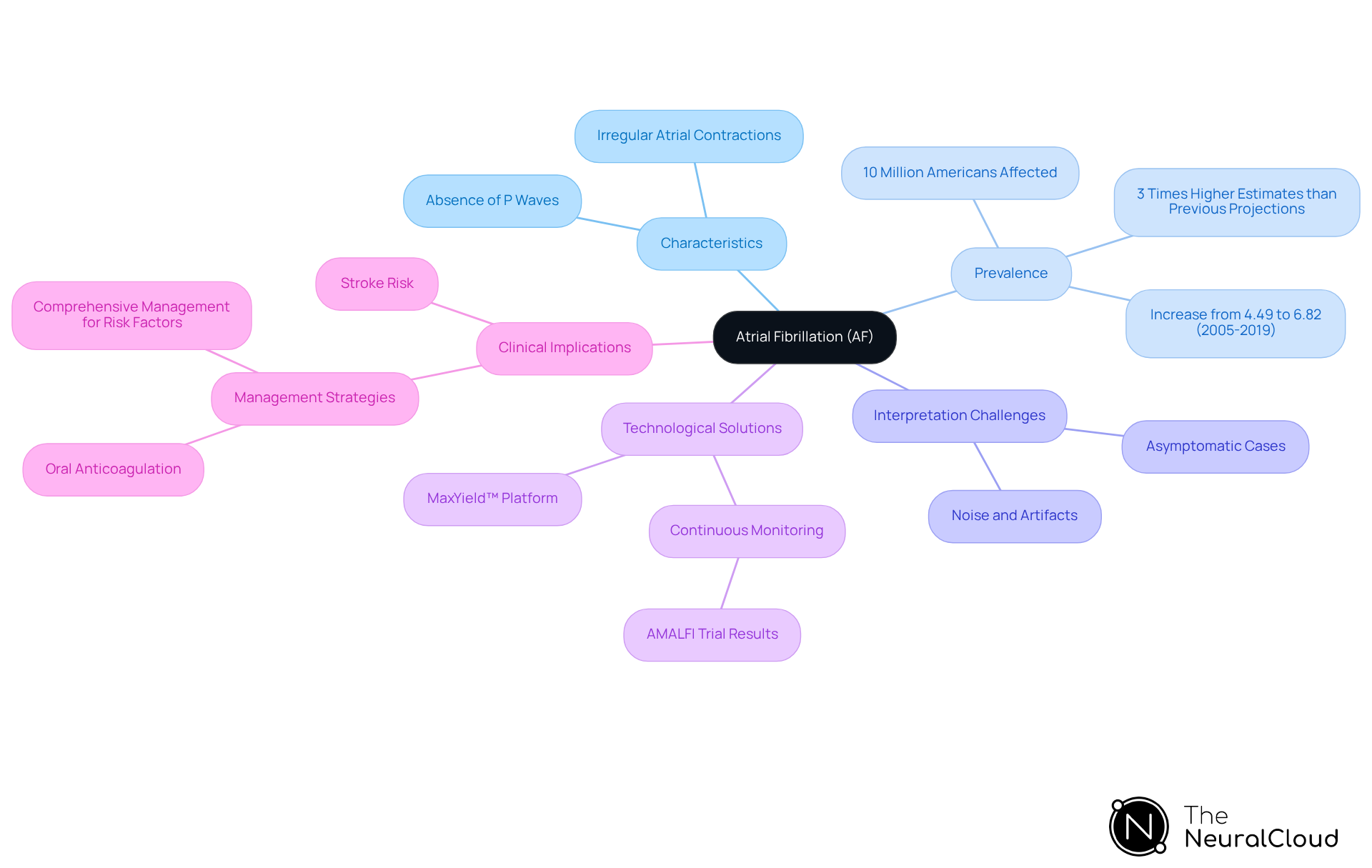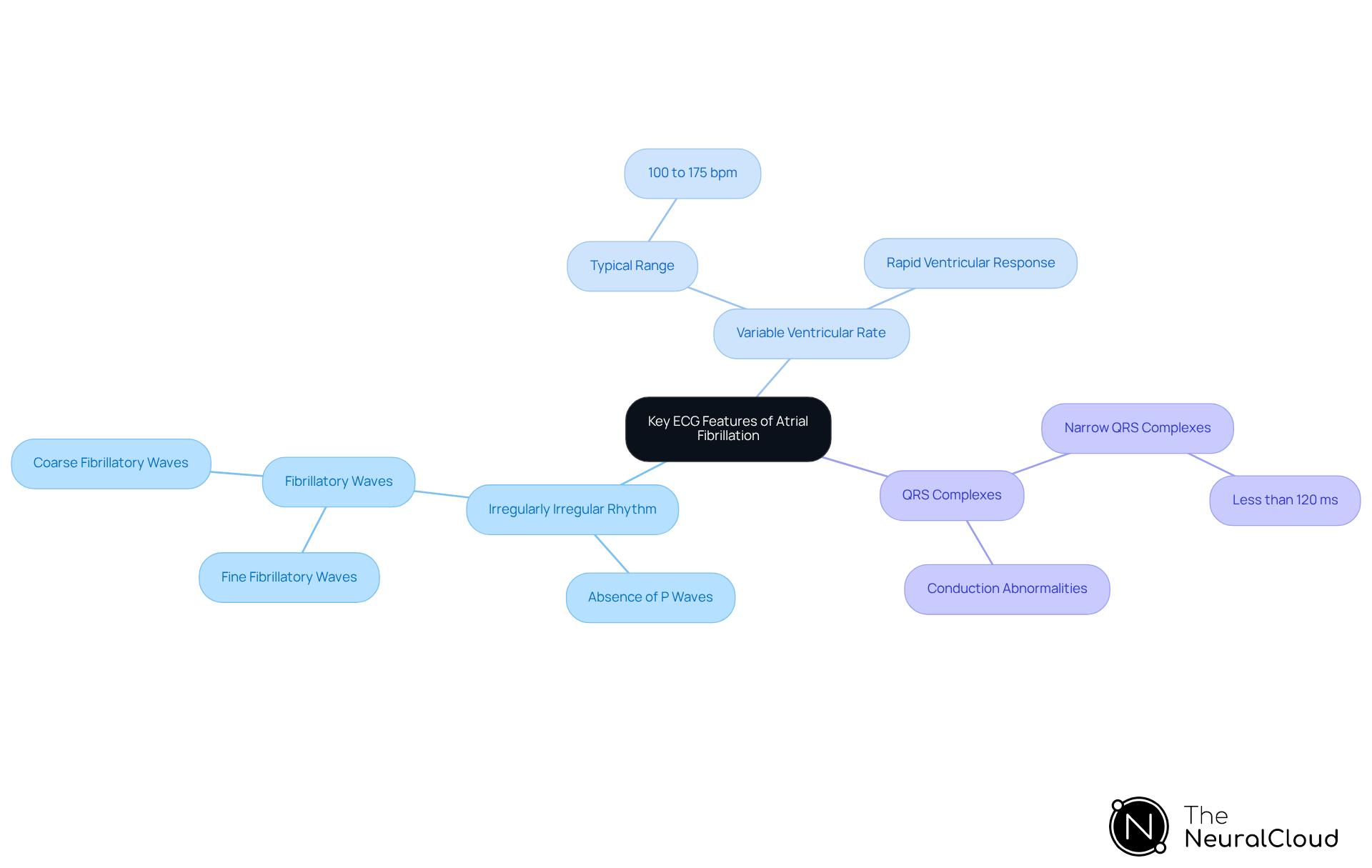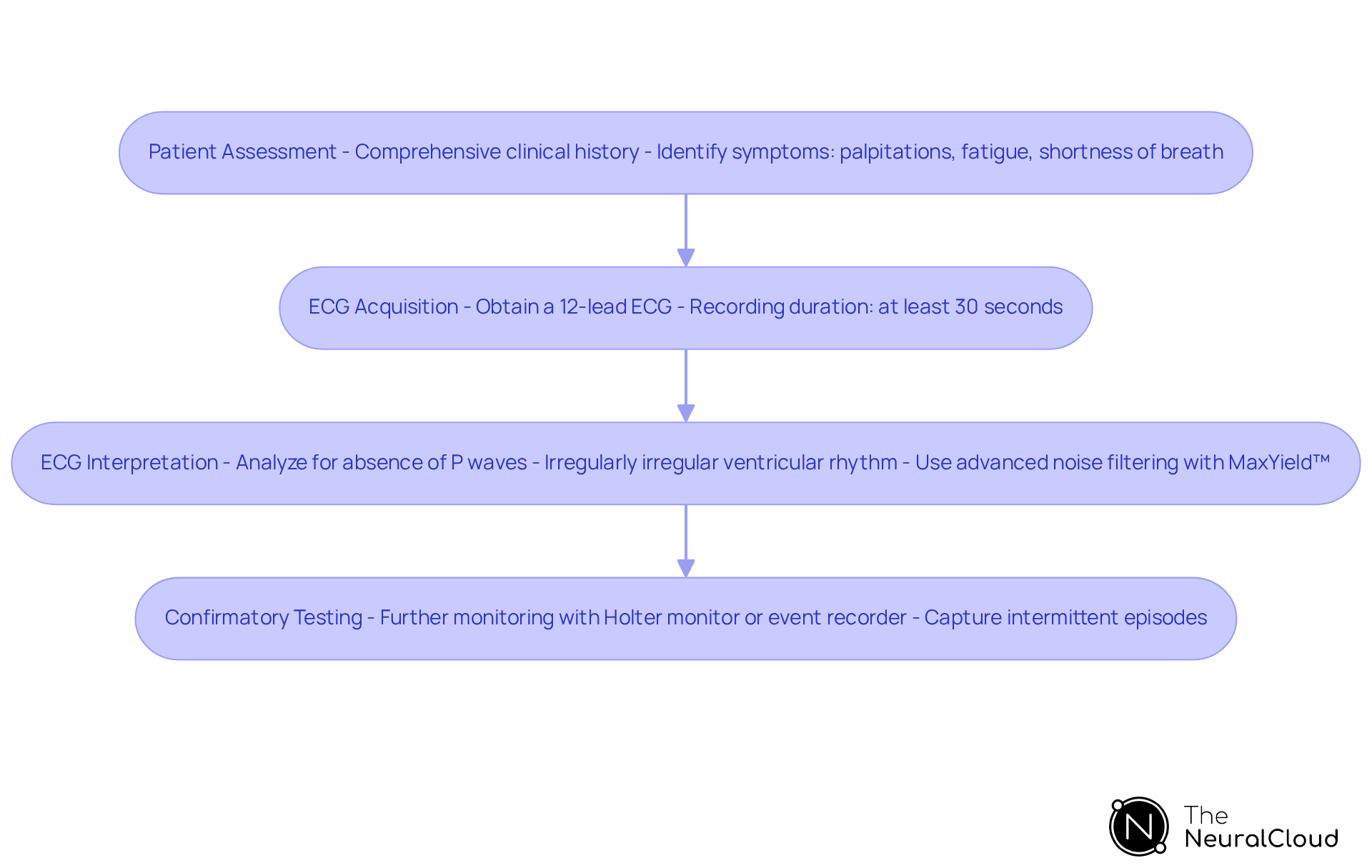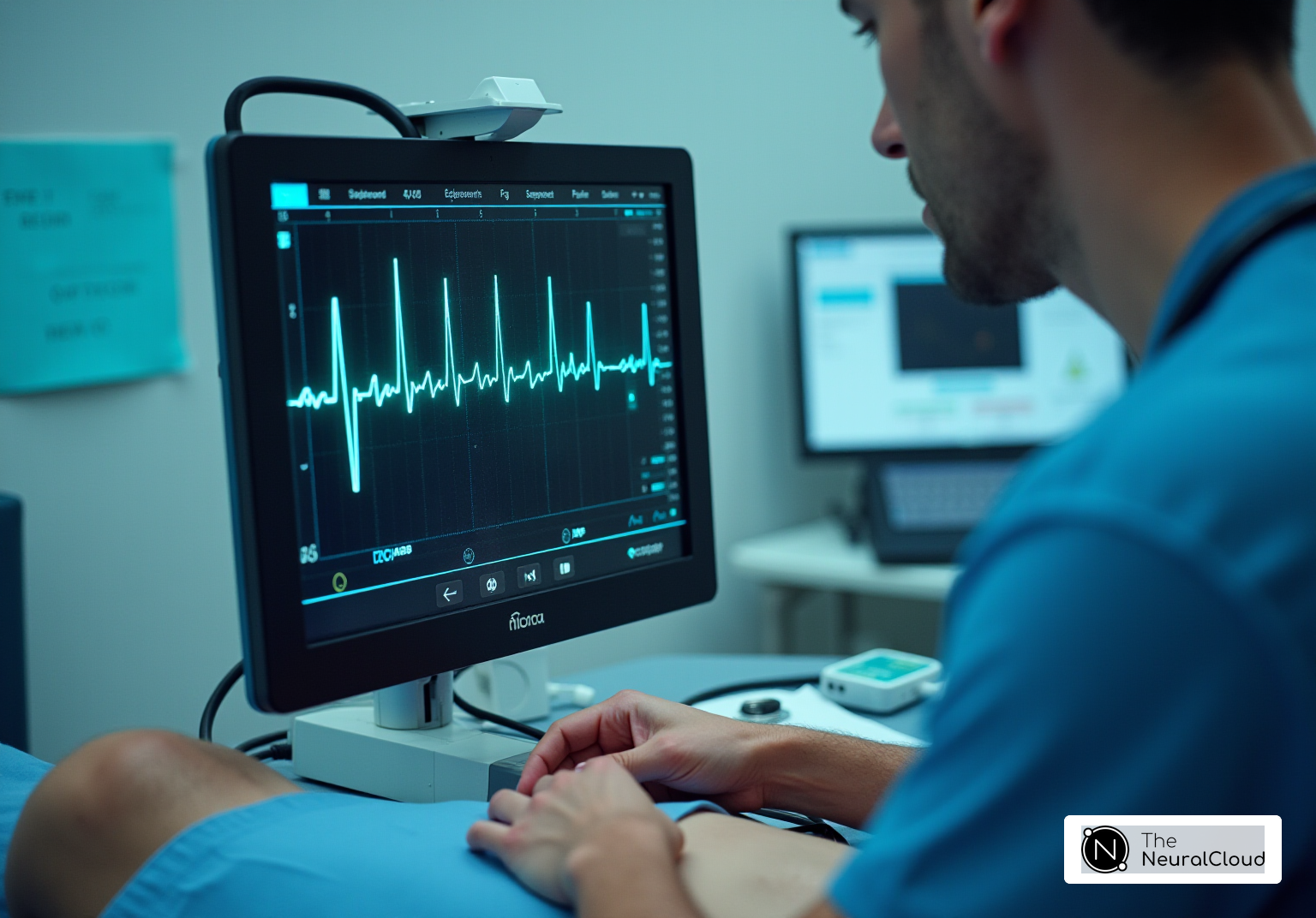Overview
This article delves into the understanding of atrial fibrillation (AF) as seen on an ECG, emphasizing its critical features and diagnostic strategies. Recognizing AF is crucial, and the article highlights specific ECG indicators, such as the absence of P waves and an irregularly irregular rhythm.
In the realm of ECG analysis, healthcare professionals often face challenges in accurately diagnosing conditions like AF. The MaxYield™ platform addresses these challenges by enhancing diagnostic accuracy through advanced technology. Its features streamline the analysis process, allowing for quicker and more reliable interpretations of ECG readings.
The advantages of utilizing the MaxYield™ platform are significant. By improving ECG analysis, healthcare professionals can make informed decisions more efficiently, ultimately leading to better patient outcomes. The platform not only aids in the recognition of AF but also supports effective management strategies that enhance overall patient care.
Introduction
Atrial fibrillation (AF) is more than just a medical term; it signifies a growing concern impacting millions and presenting serious health risks, such as strokes and heart failure. Characterized by rapid and irregular heartbeats, AF complicates ECG interpretation, making accurate diagnosis essential for timely intervention.
Healthcare professionals face challenges in identifying AF on ECGs, often hindered by noise and artifacts. What innovative strategies can enhance diagnostic accuracy and improve patient outcomes?
This article explores the key features of AF on ECG, the diagnostic process, and effective management strategies, illuminating the path forward in the fight against this prevalent arrhythmia.
Define Atrial Fibrillation and Its Impact on ECG Interpretation
Atrial fibrillation (AF) is a common cardiac arrhythmia characterized by rapid and irregular atrial contractions, which leads to ineffective atrial pumping. This condition poses significant risks, including stroke and heart failure, making the identification of afib on ecg crucial. AF is marked by the absence of distinct P waves and an irregularly irregular ventricular rhythm, complicating ECG interpretation. Recent studies show that AF affects approximately 10 million Americans, with its prevalence rising from 4.49% of adults between 2005-2009 to 6.82% between 2015-2019. This increase highlights the necessity for healthcare professionals to be skilled in recognizing afib on ecg for timely diagnosis and intervention.
Clinicians encounter various challenges when interpreting ECGs for AF. Noise and signal artifacts can obscure true ECG signals, complicating AF identification. Additionally, AF often occurs without symptoms, making it easy to overlook during routine examinations. The AMALFI trial demonstrated that home-based continuous ECG monitoring significantly improved AF detection rates, with a diagnosis rate of 6.8% in the intervention group compared to 5.4% in the control group. This underscores the importance of advanced monitoring technologies, such as Neural Cloud Solutions' offerings, in enhancing diagnostic accuracy.
The MaxYield™ platform employs sophisticated noise filtering and distinct wave recognition algorithms that evolve with each use, improving the accuracy and efficiency of ECG analysis. It quickly isolates ECG waves from recordings affected by baseline wander, movement, and muscle artifacts, allowing for clearer identification of AF features. Additionally, MaxYield™ provides beat-by-beat analysis, delivering insights from 200,000 heartbeats in less than 5 minutes, and can recover previously obscured sections of lengthy Holter, 1-Lead, and patch monitor recordings.
Complications related to AF, such as increased stroke risk, necessitate a comprehensive understanding of AFib on ECG manifestations. Effective stroke risk evaluation is crucial, especially for individuals with additional risk factors like hypertension and diabetes, which are prevalent among those with AF. Notably, 28% of participants in the AMALFI trial had diabetes, emphasizing the need for comprehensive management strategies. As the demographic of AF individuals skews younger, with a notable rise in those under 65, the demand for innovative diagnostic strategies becomes even more pressing.
In summary, recognizing the key features of afib on ecg is essential for clinicians. The incorporation of cutting-edge technologies, like Neural Cloud Solutions' platform, can help address the challenges of AF detection, ultimately enhancing outcomes for individuals and optimizing resource distribution in clinical environments.

Identify Key ECG Features of Atrial Fibrillation
Key ECG features of atrial fibrillation (AF) include:
- Irregularly Irregular Rhythm: The ventricular rhythm is chaotic, lacking a predictable pattern, which is a hallmark of AF. The absence of P waves indicates afib on ecg, where distinct P waves are missing and instead, fibrillatory waves are observed, characterized by their small and erratic nature.
- Variable Ventricular Rate: The ventricular rate can fluctuate significantly, typically ranging from 100 to 175 beats per minute, which is indicative of afib on ecg reflecting the disorganized electrical activity in the atria.
- QRS Complexes: Generally, the QRS complexes are narrow, measuring less than 120 milliseconds, unless there is a pre-existing conduction abnormality.
Recognizing these features is essential for differentiating AF, which can be identified as afib on ecg, from other arrhythmias, such as atrial flutter or sinus tachycardia, that may exhibit similar irregularities. For instance, atrial flutter often presents with a more organized rhythm and identifiable flutter waves, while sinus tachycardia maintains a regular rhythm despite a rapid rate. Understanding these differences is crucial for accurate diagnosis and effective management of individuals with afib on ecg.

Explain the Diagnostic Process for Atrial Fibrillation Using ECG
The diagnostic process for atrial fibrillation (AF) using ECG involves several critical steps:
-
Patient Assessment: Start with a comprehensive clinical history and physical examination to identify symptoms such as palpitations, fatigue, or shortness of breath. These symptoms are often overlooked yet serve as significant indicators of AF.
-
ECG Acquisition: Obtain a 12-lead ECG, ensuring the recording lasts at least 30 seconds. This duration is crucial for accurately capturing the heart's rhythm and detecting afib on ecg, as shorter recordings may miss intermittent episodes.
-
ECG Interpretation: Analyze the ECG for key features indicative of afib on ecg, such as the absence of P waves, an irregularly irregular ventricular rhythm, and a variable ventricular rate. Traditional ECG interpretation can struggle with noise and artifacts. However, with Neural Cloud Solutions' MaxYield™, healthcare professionals can utilize advanced noise filtering and distinct wave recognition to enhance clarity and accuracy. This platform evolves with each use, continuously improving its diagnostic yield and addressing challenges such as physiological variability and signal artifacts.
-
Confirmatory Testing: If AF is suspected but not confirmed, further monitoring with a Holter monitor or event recorder may be necessary to capture intermittent episodes. Approximately one-third of individuals with AF are unaware of their condition.
Following these steps aligns with the latest guidelines for diagnosing AF, including the updated ACC/AHA guideline for the diagnosis and management of afib on ecg. This guideline emphasizes the importance of thorough assessment and appropriate monitoring strategies. Notably, over 5 million adults in the U.S. currently have AFib, with projections of more than 12 million by 2030, underscoring the critical need for accurate diagnosis. Additionally, lifestyle changes, such as weight control and reducing caffeine consumption, are important in managing AF and should be considered in care. This thorough method not only aids in prompt management but also enhances the precision of AF diagnosis, ultimately improving outcomes for individuals.

Outline Management Strategies for Atrial Fibrillation Based on ECG Findings
Management strategies for afib on ECG findings involve several key approaches, significantly enhanced by Neural Cloud Solutions' MaxYield™ technology. This platform transforms lengthy and noisy ECG recordings into clear signals, addressing common challenges in ECG analysis.
-
Rate Control: Medications like beta-blockers and calcium channel blockers are frequently used to manage ventricular rates, especially in symptomatic patients. These medications help alleviate symptoms by slowing the heart rate during AF episodes. The clarity provided by MaxYield™ aids in accurately assessing the necessity for these treatments.
-
Rhythm Control: For patients with persistent AF or those who remain symptomatic despite rate control, antiarrhythmic medications or electrical cardioversion may be considered. This approach aims to restore normal sinus rhythm, significantly improving quality of life. The advanced AI technology of MaxYield™ ensures precise analysis of ECG waveforms, including the identification of afib on ecg, facilitating informed decision-making in rhythm control strategies.
-
Anticoagulation Therapy: The CHA2DS2-VASc score is vital for evaluating stroke risk in AF patients. Initiating anticoagulation treatment for individuals at moderate to high risk is crucial to prevent thromboembolic events, as AF is associated with a notable increase in stroke probability—accounting for approximately 15-25% of all strokes in the United States. Clear ECG readings from MaxYield™ enhance the accuracy of risk assessments related to afib on ecg.
-
Client Education: Educating patients about lifestyle changes—such as dietary adjustments, regular exercise, and the importance of medication adherence—is essential for effective long-term AF management. Empowering individuals with knowledge can lead to improved health outcomes and better adherence to treatment plans. Insights from precise ECG analysis can be instrumental in customizing educational efforts to meet individual client needs.
These strategies should be tailored to each patient's clinical situation, considering their overall health, preferences, and specific ECG findings. Recent studies suggest that rhythm control therapy may provide long-term benefits, particularly for younger patients with fewer comorbidities, while older patients often benefit more from rate control strategies. Continuous monitoring and reassessment of thromboembolic risk are also recommended to ensure timely interventions and adjustments in treatment as needed, supported by the clarity and speed of analysis provided by MaxYield™.

Conclusion
A thorough understanding of atrial fibrillation (AF) and its implications for ECG interpretation is vital for healthcare professionals. Accurately identifying AF on ECGs aids in timely diagnosis and plays a crucial role in managing associated risks, such as stroke and heart failure. As AF becomes increasingly prevalent, enhancing diagnostic skills and employing advanced technologies, like Neural Cloud Solutions' MaxYield™, is essential for effective patient care.
The article highlights key features of AF on ECG, including:
- The irregularly irregular rhythm
- Absence of P waves
- Variable ventricular rates
It outlines the diagnostic process, emphasizing the importance of:
- Comprehensive patient assessment
- Proper ECG acquisition
- Interpretation
Additionally, it discusses management strategies that incorporate:
- Rate and rhythm control
- Anticoagulation therapy
- Patient education
All informed by precise ECG analysis.
Recognizing and addressing the complexities of AF through improved diagnostic strategies can significantly enhance patient outcomes. As the healthcare landscape evolves, embracing innovative technologies and comprehensive management approaches will be crucial for clinicians to effectively combat the challenges posed by atrial fibrillation. This proactive stance optimizes clinical resources and empowers patients to take charge of their health, leading to better long-term results in managing this common arrhythmia.
Frequently Asked Questions
What is atrial fibrillation (AF)?
Atrial fibrillation is a common cardiac arrhythmia characterized by rapid and irregular atrial contractions, leading to ineffective atrial pumping.
What are the risks associated with atrial fibrillation?
Atrial fibrillation poses significant risks, including stroke and heart failure.
How does atrial fibrillation affect ECG interpretation?
AF complicates ECG interpretation due to the absence of distinct P waves and an irregularly irregular ventricular rhythm.
What is the prevalence of atrial fibrillation in the United States?
Recent studies indicate that approximately 10 million Americans have AF, with its prevalence increasing from 4.49% of adults (2005-2009) to 6.82% (2015-2019).
What challenges do clinicians face when interpreting ECGs for AF?
Clinicians encounter challenges such as noise and signal artifacts that can obscure true ECG signals, and AF often occurs without symptoms, making it easy to overlook.
What did the AMALFI trial demonstrate regarding AF detection?
The AMALFI trial showed that home-based continuous ECG monitoring significantly improved AF detection rates, with a diagnosis rate of 6.8% in the intervention group compared to 5.4% in the control group.
How does the MaxYield™ platform enhance ECG analysis?
The MaxYield™ platform uses sophisticated noise filtering and distinct wave recognition algorithms, which improve the accuracy and efficiency of ECG analysis by isolating ECG waves from recordings affected by artifacts.
What additional features does MaxYield™ provide?
MaxYield™ offers beat-by-beat analysis, delivering insights from 200,000 heartbeats in less than 5 minutes, and can recover previously obscured sections of lengthy Holter, 1-Lead, and patch monitor recordings.
Why is effective stroke risk evaluation important for individuals with AF?
Effective stroke risk evaluation is crucial, especially for individuals with additional risk factors like hypertension and diabetes, which are common among those with AF.
What demographic trends are observed in atrial fibrillation patients?
The demographic of AF patients is skewing younger, with a notable rise in individuals under 65, highlighting the need for innovative diagnostic strategies.






